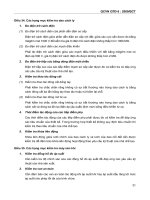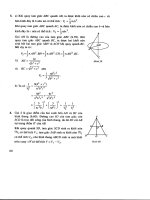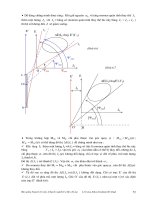Dairy Farm Energy Management Handbook phần 5 pptx
Bạn đang xem bản rút gọn của tài liệu. Xem và tải ngay bản đầy đủ của tài liệu tại đây (42.96 KB, 10 trang )
Milking Research and Instruction Laboratory (UWMRIL)
The University of Wisconsin
Biological Systems Engineering Dept. Laboratory
540 Elm Drive
Madison, WI 53706
Web: www.uwex.edu/uwmril/index.html
Energy Center of Wisconsin
455 Science Drive, Suite 200
Madison, WI 53711
Web:
Appendix - Associations & Organizations
Midwest Rural Energy Council
460 Henry Mall
University of Wisconsin-Madison
Madison, WI 53706
Phone: 608-262-1228 (fax)
E-mail:
Web: www.mrec.org
Wisconsin Electric Cooperative Assoc.
131 West Wilson Street Suite 400
Madison, WI 53703
Phone: 608-258-4400
Fax: 608-258-4407
Web: www.weca.coop/index.html
National Food and Energy Council
P.O. Box 309
2333 Rombach Ave.
Wilmington, OH 45177
Phone: 937-383-0001
Fax: 937-383-0003
E-mail:
Web: www.nfec.org/
National Electrical Manufacturers Assoc. (NEMA)
1300 North 17th Street / Suite 1847
Rosslyn, VA 22209
Phone: 703-841-3200
Fax: 703-841-5900
Web: www.nema.org
National Fire Protection Assoc. (NFPA)
1 Batterymarch Park
Quincy, MA 02169-7471
Phone: 1-800-344-3555
Fax: 617-770-0700
Web: www.nfpa.org
National Rural Electric Cooperative Assn. (NRECA)
4301 Wilson Blvd.
Arlington, VA 22203
Phone: 703-907-5500
E-mail:
Web: www.nreca.org
Note: The NRECA is the national service organization representing the
national interests of cooperative electric utilities and the consumers they
serve.
Consortium for Energy Efficiency, Inc. (CEE)
98 North Washington St. / Suite 101
Boston MA 02114-1918
Phone: 617-589-3949
Fax: 617-589-3948
Web: www.cee1.org
Note: CEE is a national, nonprofit organization that promotes energy-efficient
products and services.
American Council for an Energy-Efficient Economy (ACEEE)
1001 Connecticut Avenue, NW Suite 801
Washington, DC 20036
Phone: 202-429-8873
Fax: 202-429-2248
E-mail:
Web: www.aceee.org
Note: The ACEEE is a nonprofit organization dedicated to advancing energy
efficiency as a means of promoting both economic prosperity and
environmental protection.
National Mastitis Council (NMC)
421 S. Nine Mound Rd.
Verona, WI 53953 USA
Phone: (608) 848-4615
Fax: (608) 848-4671
Web:
Note: Web site contains information and links relating to milking systems.
Appendix - Web Sites
Wisconsin Focus on Energy / Dairy
Web: www.uwex.edu/energy/dairy.html
Note: This site contains specific links to various dairy energy related topics.
Stray Voltage information
(University of Wisconsin Milking Research and Instruction Laboratory)
available at web:
Univ. of Wisconsin Energy Efficiency and Renewable Energy Resource Site
Contain information and link on energy efficiency in agriculture, wind, solar,
methane digesters, residential energy efficiency and more.
Appendix - Contacts for Rewiring Programs
Alliant Energy
Web: www.alliantenergy.com/
Note: Click on top heading, “Utility Services,” and then click on “Farm.”
Wisconsin Public Service
/>
Wisconsin Electric Cooperative Association
p/we/safetyfirstfp.htm
Xcel Energy
Note: Click on “Business” at top heading and go to “Program & Resources”
and then select and type in zip code that most closely matches your service
location (i.e., 54701 for Eau Claire). The topic/link, “Farm Rewiring”, appears
in the left-hand column of web page.
WE Energies
Appendix - Publications
University of Wisconsin – Cooperative Extension Service Publications
(
Go to upper, left-hand column and click on “Agriculture” and then go to
“Energy, Engineering, Environment, Safety” heading. This will take you link
you a page full of energy and equipment related publications and fact sheets
which are available as hard copies (for a modest fee) or as pdf files.
Low-Cost Energy Conservation: General Farm Enterprise (A3784-9),
Scott Sanford, Univ. of Wisconsin Extension, 2003.
Available as pdf file at:
Ventilation and Cooling Systems for Animal Housing (A3784-6), Scott
Sanford, Univ. of Wisconsin Extension, 2004.
Available as pdf file at:
Heating Water on Dairy Farms (A3784-2), Scott Sanford, Univ. of Wisconsin
Extension, 2003.
Available as pdf file at:
Maintenance of Milking and Milk Handling Equipment, Ontario Ministry of
Agriculture, Food and Rural Affairs.
Fact Sheet available at:
Long-day Lighting in Dairy Barns, University of Wisconsin – Madison.
Available at web:
Lighting Dairy Facilities, University of Minnesota, Updated 2002.
Available at web: www.bae.umn.edu/extens/ennotes/ensum99/lighting.html
Dairy Lighting System for Free-stall Barns and Milking Centers, updated
2004.
Available at web: www.bae.umn.edu/extens/aeu/aeu12.html
Agricultural Ventilation Fans, Performance and Efficiencies, published by
the BESS Lab, Univ. of Illinois, offers an unbiased source of performance data
for more than 300 commercially available ventilation fans.
Ordering information is available at:
www.age.uiuc.edu/bee/Research/handbook/handbook.html
Fan Selection and Maintenance, Kansas State University, March 2001, EP
75.
Available as pdf file at: www.oznet.ksu.edu/library/lvstk2/ep75.pdf
Selecting Rated Ventilation Fans (G 85), Pennsylvania State Agricultural
and Biological Engineering, 1996.
Available as pdf file at: www.age.psu.edu/extension/factsheets/g/G85.pdf
Wisconsin Electrical Dairy Equipment Survey Results, May 2005,
provides a very updated and condensed overview of opinions from numerous
dairy operations about stray voltage matters and the use of electrical
equipment.
The survey is available as a pdf file at:
www.nass.usda.gov/wi/dairy/dy_elect_equip.pdf
Stray Voltage and Electrical Safety Problems Go Hand-in-Hand:
Published by University of Minnesota, updated 2004.
A vailable on web at:
Installation and Operation Of Electric Fences, Cow Trainers and Crowd
Gates - A Self-Help Guide: Published by the Midwest Rural Energy Council
(MREC).
Complete guide is available as pdf on line at:
Farm Rewiring Program Bulletin, published by Wis. Dept. of Agriculture, Trade
& Consumer Protection.
A vailable as pdf file at: www.datcp.state.wi.us/mktg/agriculture/farm-
center/pdf/farm_rewiring_newsletter.pdf
Agricultural Wiring Handbook, 13th Edition, 2002, published by the National
Food and Energy Council, P.O. Box 309, 2333 Rombach Ave., Wilmington,
OH 45177. Phone: (937) 383-0001 Fax: (937) 383-0003 Web: www.nfec.org
Electrical Systems for Agricultural Buildings (Recommended Practices),
published by the University of Nebraska – Lincoln, (Bulletin No. G87-845-A,
Revised January 1993). This describes some of the specialized wiring
practices and equipment required in agricultural buildings. Presently, this
publication is not available on line; however, you may contact the following to
see if it’s available in hard copy form: UNL Publications Warehouse, P.O. Box
830918, Lincoln, NE 68583-0918.
The Midwest Plan Service (MWPS): The MWPS is a university-based
publishing cooperative dedicated to publishing and disseminating research-
based, peer-reviewed, practical, and affordable publications that support the
outreach missions of the 12 North Central Region land-grant universities plus
the U.S. Department of Agriculture (USDA). Address: 122 Davidson Hall, Iowa
State University, Ames, IA 50011-3080. Web site: www.mwpshq.org
. Phone:
1-800-562-3618 or 1-515-294-4337 Fax: 1-515-294-9589 E-mail:
Wiring Handbook for Rural Facilities, MWPS-28 (replaces Farm Buildings
Wiring Handbook, Second Edition) – Based on the National Fire Protection
Association (NFPA) 70-1990 National Electrical Code® (NEC), this handbook
shows and explains materials and methods for assessing and installing
electrical wiring in equipment and farm buildings. Standby power, alarm
systems, stray voltage, and lightning protection also are considered.
/>
Appendix - Glossary of Terms
Ampere: The measurement of the flow of an electric current through a
conductor.
Btu: The British Thermal Unit (Btu) is a precise measurement of energy. It is
the amount of energy required to raise the temperature of one pound of water
one degree Fahrenheit when the water is near 39.2 degrees Fahrenheit.
Circuit: A complete path over which an electric current can flow.
Color Rendition Index: A measure of light quality. The maximum Color
Rendition Index (CRI) value of 100 is given to natural daylight and
incandescent lighting. The closer a lamp's CRI rating is to 100, the better its
ability to show true colors to the human eye.
Conductor: An electrical path that offers comparatively little resistance. A
wire or combination of wires not insulated from one another, suitable
for carrying a single electric current. Bus bars are also conductors.
Correlated Color Temperature – or CCT (K): A specification of the color
appearance of a lamp relating its color to that of a reference source heated to
a particular temperature, measured in degrees Kelvin (K). Generally, CCT
measures the "warmth" or "coolness" of the light source appearance.
Current: The movement of electrons through a conductor (measured in
amperes, milliamperes, and microamperes).
Foot-candle: A foot-candle (fc) is a unit of measure of the intensity of light
falling on a surface, equal to one lumen per square foot of surface.
Kilowatt-hour: The kilowatt-hour (or kWh) is a unit of energy equivalent to
one kilowatt (one thousand watts) of power used continuously for one hour of
time.
Lumen: A lumen is a measurement of light output: One lumen is equal to the
amount of light emitted by one candle that falls on one square foot of surface
located one foot away from one candle.
Ohm: The unit of electrical resistance. Resistance is one ohm when a direct
current (DC) voltage of one volt will send a current of one ampere through.
Relative humidity: The ratio of water vapor contained in the air compared to
the maximum amount of moisture that the air can hold at that particular
temperature and pressure.
Volt: A basic measurement of electrical pressure or force in a circuit. Volts x
amps = watts.
Watt: The standard unit of measurement of electrical power. One watt is one
ampere of current flowing at one volt.









